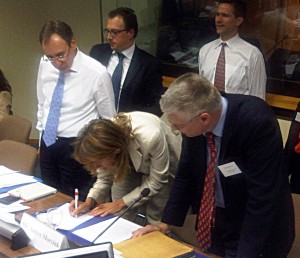Overview
The Vienna Initiative was launched in January 2009 at the height of the global financial crisis.
The Initiative has been a powerful example of a successful relationship between the public and private sectors, as it brings together all the key stakeholders in the EU-based cross-border bank groups that are active in emerging Europe.
These include major international financial institutions as well as the most important European institutions, home and host country regulatory and fiscal authorities of large cross-border bank and the largest banking groups operating in emerging Europe.
The EBRD, EIB, European Commission, IMF, and the World Bank played a key role in the creation and further development of the Vienna Initiative.
The initial key objectives of the Initiative were to:
- Prevent a large-scale and uncoordinated withdrawal of cross-border bank groups from the region, which could have triggered systemic bank crises not only in individual countries but in the region as a whole.
- Ensure that parent bank groups maintain their exposures and recapitalise their subsidiaries in emerging Europe.
- Ensure that national support packages of cross-border bank groups benefited their subsidiaries in emerging Europe and thus avoided a “home bias”.
- Agree on, and implement, basic crisis management principles in the region.
 As systemic risks started abating in the region from early 2010, the Initiative’s focus gradually shifted to critical region-wide policy issues that would make financial sectors in emerging Europe more resilient in the longer term, identified at the Initiative’s Full Forum meetings. Working Groups (WGs) were comprised with representatives from parent banks, regulators, central banks, ministries of finance, European institutions and IFIs.
As systemic risks started abating in the region from early 2010, the Initiative’s focus gradually shifted to critical region-wide policy issues that would make financial sectors in emerging Europe more resilient in the longer term, identified at the Initiative’s Full Forum meetings. Working Groups (WGs) were comprised with representatives from parent banks, regulators, central banks, ministries of finance, European institutions and IFIs.
